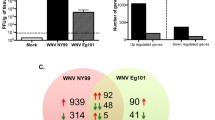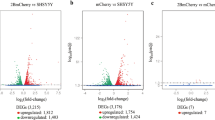Abstract
Enterovirus 71 (EV71) infection may be asymptomatic or may cause diarrhea, rashes, and hand, foot, and mouth disease (HFMD). However, EV71 also has the potential to cause severe neurological disease. To date, little is known about the molecular mechanisms of host response to EV71 infection. In this report, we utilized cDNA microarray to profile the kinetics and patterns of host gene expression in EV71-infected human neural SF268 cells. We have identified 157 genes with significant changes in mRNA expression and performed hierarchical clustering to classify these genes into five different groups based on their kinetics of expression. EV71 infection led to increases in the level of mRNAs encoding chemokines, proteins involved in protein degradation, complement proteins, and proapoptotis proteins. cDNA microarray expression comparisons of EV71- and mock-infected cells also revealed the down-regulation of several genes encoding proteins involved in host RNA synthesis. Expression of interferon-regulated proteins was increased early in the infection and then decreased. Expression of proteins involved in cellular development and differentiation, some oncogenes, and transcription and translation regulators were suppressed and then stimulated late in the infection. Our findings illustrate the overall host response to EV71 infection, and will aid in understanding the host response to this virus.
Article PDF
Similar content being viewed by others
Avoid common mistakes on your manuscript.
References
Aldabe R, Irurzun A, Carrasco L (1997). Poliovirus protein 2BC increases cytosolic free calcium concentrations. J Virol 71: 6214–6217.
Alexander JP, Jr, Baden L, Pallansch MA, Anderson LJ (1994). Enterovirus 71 infections and neurologic disease—United States, 1977–1991. J Infect Dis 169: 905–908.
Asensio VC, Campbell IL (1999). Chemokines in the CNS: plurifunctional mediators in diverse states. Trends Neurosci 22: 504–512.
Belov GA, Romanova LI, Tolskaya EA, Kolesnikova MS, Lazebnik YA, Agol VI (2003). The major apoptotic pathway activated and suppressed by poliovirus. J Virol 77: 45–56.
Browne EP, Shenk T (2003). Human cytomegalovirus UL83-coded pp65 virion protein inhibits antiviral gene expression in infected cells. Proc Natl Acad Sci U S A 100: 11439–11444.
Chang LY, Lin TY, Hsu KH, Huang YC, Lin KL, Hsueh C, Shih SR, Ning HC, Hwang MS, Wang HS, Lee CY (1999). Clinical features and risk factors of pulmonary oedema after enterovirus-71-related hand, foot, and mouth disease. Lancet 354: 1682–1686.
Chang YE, Laimins LA (2000). Microarray analysis identifies interferon-inducible genes and Stat-1 as major transcriptional targets of human papillomavirus type 31. J Virol 74: 4174–4182.
Chen CY, Chang YC, Huang CC, Lui CC, Lee KW, Huang SC (2001). Acute flaccid paralysis in infants and young children with enterovirus 71 infection: MR imaging findings and clinical correlates. AJNR Am J Neuroradiol 22: 200–205.
Conant K, Ahmed U, Schwartz JP, Major EO (1998). IFN-gamma inhibits AP-1 binding activity in human brain-derived cells through a nitric oxide dependent mechanism. J Neuroimmunol 88: 39–44.
Cuadras MA, Feigelstock DA, An S, Greenberg HB (2002). Gene expression pattern in Caco-2 cells following rotavirus infection. J Virol 76: 4467–4482.
Der SD, Zhou A, Williams BR, Silverman RH (1998). Identification of genes differentially regulated by interferon alpha, beta, or gamma using oligonucleotide arrays. Proc Natl Acad Sci U S A 95: 15623–15628.
Donato R (1999). Functional roles of S100 proteins, calcium-binding proteins of the EF-hand type. Biochim Biophys Acta 1450: 191–231.
Eisen MB, Spellman PT, Brown PO, Botstein D (1998). Cluster analysis and display of genome-wide expression patterns. Proc Natl Acad Sci U S A 95: 14863–14868.
Espert L, Degols G, Gongora C, Blondel D, Williams BR, Silverman RH, Mechti N (2003). ISG20, a new interferon-induced RNase specific for single-stranded RNA, defines an alternative antiviral pathway against RNA genomic viruses. J Biol Chem 278: 16151–16158.
Gale M, Jr, Katze MG (1998). Molecular mechanisms of interferon resistance mediated by viral-directed inhibition of PKR, the interferon-induced protein kinase. Pharmacol Ther 78: 29–46.
Gasque P, Dean YD, McGreal EP, VanBeek J, Morgan BP (2000). Complement components of the innate immune system in health and disease in the CNS. Immunopharmacology 49: 171–186.
Geiss GK, An MC, Bumgarner RE, Hammersmark E, Cunningham D, Katze MG (2001). Global impact of influenza virus on cellular pathways is mediated by both replication-dependent and -independent events. J Virol 75: 4321–4331.
Geiss GK, Bumgarner RE, An MC, Agy MB, ’t Wout AB, Hammersmark E, Carter VS, Upchurch D, Mullins JI, Katze MG (2000). Large-scale monitoring of host cell gene expression during HIV-1 infection using cDNA microarrays. Virology 266: 8–16.
Geiss GK, Salvatore M, Tumpey TM, Carter VS, Wang X, Basler CF, Taubenberger JK, Bumgarner RE, Palese P, Katze MG, Garcia-Sastre A (2002). Cellular transcriptional profiling in influenza A virus-infected lung epithelial cells: the role of the nonstructural NS1 protein in the evasion of the host innate defense and its potential contribution to pandemic influenza. Proc Natl Acad Sci U S A 99: 10736–10741.
Gilbert GL, Dickson KE, Waters MJ, Kennett ML, Land SA, Sneddon M (1988). Outbreak of enterovirus 71 infection in Victoria, Australia, with a high incidence of neurologic involvement. Pediatr Infect Dis J 7: 484–488.
Hirsch RL, Griffin DE, Winkelstein JA (1978). The effect of complement depletion on the course of Sindbis virus infection in mice. J Immunol 121: 1276–1278.
Ho M, Chen ER, Hsu KH, Twu SJ, Chen KT, Tsai SF, Wang JR, Shih SR (1999). An epidemic of enterovirus 71 infection in Taiwan. Taiwan Enterovirus Epidemic Working Group. N Engl J Med 341: 929–935.
Irurzun A, Arroyo J, Alvarez A, Carrasco L (1995). Enhanced intracellular calcium concentration during poliovirus infection. J Virol 69: 5142–5146.
Johnston C, Jiang W, Chu T, Levine B (2001). Identification of genes involved in the host response to neurovirulent alphavirus infection. J Virol 75: 10431–10445.
Kudoh K, Ramanna M, Ravatn R, Elkahloun AG, Bittner ML, Meltzer PS, Trent JM, Dalton WS, Chin KV (2000). Monitoring the expression profiles of doxorubicin-induced and doxorubicin-resistant cancer cells by cDNA microarray. Cancer Res 60: 4161–4166.
Kuo RL, Kung SH, Hsu YY, Liu WT (2002). Infection with enterovirus 71 or expression of its 2 A protease induces apoptotic cell death. J Gen Virol 83: 1367–1376.
Labrada L, Liang XH, Zheng W, Johnston C, Levine B (2002). Age-dependent resistance to lethal alphavirus encephalitis in mice: analysis of gene expression in the central nervous system and identification of a novel interferon-inducible protective gene, mouse ISG12. J Virol 76: 11688–11703.
Lane TE, Liu MT, Chen BP, Asensio VC, Samawi RM, Paoletti AD, Campbell IL, Kunkel SL, Fox HS, Buchmeier MJ (2000). A central role for CD4 (+) T cells and RANTES in virus-induced central nervous system inflammation and demyelination. J Virol 74: 1415–1424.
Leong PW, Liew K, Lim W, Chow VT, Cuadras MA, Feigelstock DA, An S, Greenberg HB (2002). Differential display RT-PCR analysis of enterovirus-71-infected rhabdomyosarcoma cells reveals mRNA expression responses of multiple human genes with known and novel functions Gene expression pattern in Caco-2 cells following rotavirus infection. Virology 295: 147–159.
Levine B (2002). Apoptosis in viral infections of neurons: a protective or pathologic host response? Curr Top Microbiol Immunol 265: 95–118.
Lewis J, Wesselingh SL, Griffin DE, Hardwick JM (1996). Alphavirus-induced apoptosis in mouse brains correlates with neurovirulence. J Virol 70: 1828–1835.
Li ML, Hsu TA, Chen TC, Chang SC, Lee JC, Chen CC, Stollar V, Shih SR (2002). The 3C protease activity of enterovirus 71 induces human neural cell apoptosis. Virology 293: 386–395.
McMinn PC (2002). An overview of the evolution of enterovirus 71 and its clinical and public health significance. FEMS Microbiol Rev 26: 91–107.
Morgan RW, Sofer L, Anderson AS, Bernberg EL, Cui J, Burnside J (2001). Induction of host gene expression following infection of chicken embryo fibroblasts with oncogenic Marek’s disease virus. J Virol 75: 533–539.
Palmer P, Charley B, Rombaut B, Daeron M, Lebon P (2000). Antibody-dependent induction of type I interferons by poliovirus in human mononuclear blood cells requires the type II fcgamma receptor (CD32). Virology 278: 86–94.
Pestka S (2000). The human interferon alpha species and receptors. Biopolymers 55: 254–287.
Talon J, Horvath CM, Polley R, Basler CF, Muster T, Palese P, Garcia-Sastre A (2000). Activation of interferon regulatory factor 3 is inhibited by the influenza A virus NS1 protein. J Virol 74: 7989–7996.
van Kuppeveld FJ, Hoenderop JG, Smeets RL, Willems PH, Dijkman HB, Galama JM, Melchers WJ (1997). Coxsackievirus protein 2B modifies endoplasmic reticulum membrane and plasma membrane permeability and facilitates virus release. EMBO J 16: 3519–3532.
Wang SM, Lei HY, Huang KJ, Wu JM, Wang JR, Yu CK, Su IJ, Liu CC (2003). Pathogenesis of enterovirus 71 brainstem encephalitis in pediatric patients: roles of cytokines and cellular immune activation in patients with pulmonary edema. J Infect Dis 188: 564–570.
Zhu H, Cong JP, Mamtora G, Gingeras T, Shenk T (1998). Cellular gene expression altered by human cytomegalovirus: global monitoring with oligonucleotide arrays. Proc Natl Acad Sci U S A 95: 14470–14475.
Zimring JC, Goodbourn S, Offermann MK (1998). Human herpesvirus 8 encodes an interferon regulatory factor (IRF) homolog that represses IRF-1-mediated transcription. J Virol 72: 701–707.
Author information
Authors and Affiliations
Corresponding author
Additional information
This investigation was supported by grant NSC92-3112-B-182-001 from the National Science Council, Taiwan, to Shin-Ru Shih.
Rights and permissions
About this article
Cite this article
Shih, SR., Stollar, V., Lin, JY. et al. Identification of genes involved in the host response to enterovirus 71 infection. Journal of NeuroVirology 10, 293–304 (2004). https://doi.org/10.1080/13550280490499551
Received:
Revised:
Accepted:
Issue Date:
DOI: https://doi.org/10.1080/13550280490499551




